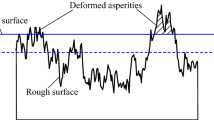Abstract
Without considering the influence of heat, existing fractal contact models are not applicable to analyze the contacts when the temperature changes. For this problem, the normal load model and the normal stiffness model of thermal elasto-plastic contact of rough surfaces are developed respectively in this paper. The proposed model is based on the normal contact mechanics model of fractal theory of anisotropic and thermal elasto-plastic contact theory which can be used to characterize the rough surface thermodynamic properties. Then the validity of the model is verified. Finally, the influence of main parameters on the total normal load and the whole normal stiffness of thermal elasto-plastic contact at the interface is analyzed by contact simulation. The results show that the total normal load of thermal elasto-plastic contact increases with the increases of temperature. The whole normal stiffness of thermal elasto-plastic contact increases with increasing coefficient of linear expansion, scale factor, temperature difference or fractal dimension, but decreases with increasing fractal roughness. This model expands basic theory and applications of traditional models, and can be used to calculate and analyze the contacts when the temperature changes.
摘要
针对现有分形接触模型没有考虑热应力的影响、不适用于结合部温度变化的问题,基于各向异性分形理论和热弹塑性接触理论,本文分别建立了粗糙表面热弹塑性接触的法向载荷模型和法向刚度模型,并验证了模型的有效性,该模型可用于表征粗糙表面的热力学特性。通过数字仿真,分别分析了主要参数对粗糙表面热弹塑性接触法向载荷和法向刚度的影响。结果表明:热弹塑性接触法向载荷随结合部温差的增大而增大; 热弹塑性接触法向刚度随着线膨胀系数、比例系数、温差、分形维数的增大而增大,随表面粗糙度的增大而减小。该模型是对传统模型在基础理论和应用范围上的拓展,可用于计算和分析工程实际中大量存在的结合部温度发生改变的接触情况。
Similar content being viewed by others
References
SANTAMARIA R, PAZ A A, ROSKOP L, et al. Statistical contact model for confined molecules [J]. Journal of Statistical Physics, 2016, 164(4): 1000–1025. DOI: https://doi.org/10.1007/s10955-016-1569-x.
XIAO Hui-fang, SUN Yun-yun. On the normal contact stiffness and contact resonance frequency of rough surface contact based on asperity micro-contact statistical models [J]. European Journal of Mechanics-A/Solids, 2019, 75: 450–460. DOI: https://doi.org/10.1016/j.euromechsol.2019.03.004.
YUAN Wei-ke, LONG Jian-min, DING Yue, et al. Statistical contact model of rough surfaces: The role of surface tension [J]. International Journal of Solids and Structures, 2018, 138: 217–223. DOI: https://doi.org/10.1016/j.ijsolstr.2018.01.014.
ZHAO Zhi-fang, HAN Hong-zheng, WANG Peng-fei, et al. An improved model for meshing characteristics analysis of spur gears considering fractal surface contact and friction [J]. Mechanism and Machine Theory, 2021, 158: 104219. DOI: https://doi.org/10.1016/j.mechmachtheory.2020.104219.
LONG J M, WANG G F, FENG X Q, et al. Influence of surface tension on fractal contact model [J]. Journal of Applied Physics, 2014, 115(12): 123522. DOI: https://doi.org/10.1063/1.4869742.
HUO Lin-sheng, WANG Fu-rui, LI Hong-nan, et al. A fractal contact theory based model for bolted connection looseness monitoring using piezoceramic transducers [J]. Smart Materials and Structures, 2017, 26(10): 104010. DOI: https://doi.org/10.1088/1361-665x/aa6e93.
JANA T, MITRA A, SAHOO P. Dynamic contact interactions of fractal surfaces [J]. Applied Surface Science, 2017, 392: 872–882. DOI: https://doi.org/10.1016/j.apsusc.2016.09.025.
ZHAO Yong-sheng, WU Hong-chao, LIU Zhi-feng, et al. A novel nonlinear contact stiffness model of concrete-steel joint based on the fractal contact theory [J]. Nonlinear Dynamics, 2018, 94(1): 151–164. DOI: https://doi.org/10.1007/s11071-018-4350-7.
YAN W, KOMVOPOULOS K. Contact analysis of elastic-plastic fractal surfaces [J]. Journal of Applied Physics, 1998, 84(7): 3617–3624. DOI: https://doi.org/10.1063/1.368536.
GOERKE D, WILLNER K. Normal contact of fractal surfaces—Experimental and numerical investigations [J]. Wear, 2008, 264(7, 8): 589–598. DOI: https://doi.org/10.1016/j.wear.2007.05.004.
JIANG Shu-yun, ZHENG Yun-jian, ZHU Hua. A contact stiffness model of machined plane joint based on fractal theory [J]. Journal of Tribology, 2010, 132(1): 011401. DOI:https://doi.org/10.1115/1.4000305.
WEN Shu-hua, ZHANG Xue-liang, WU Mei-xian, et al. Fractal model and simulation of normal contact stiffness of joint interfaces and its simulation [J]. Transactions of the Chinese Society for Agricultural Machinery, 2009, 40(11): 197–202. (in Chinese)
LAN Guo-sheng, ZHANG Xue-liang, DING Hong-qin, et al. Modified contact model of joint interfaces based on fractal theory [J]. Transactions of the Chinese Society for Agricultural Machinery, 2011, 42(10): 217–223, 229. (in Chinese)
TIAN Hong-liang, ZHONG Xian-you, QIN Hong-ling, et al. Normal contact mechanics model of fixed joint interface adopting anisotropic fractal geometrical theory [J]. Journal of Mechanical Engineering, 2013, 49(21): 108–122. (in Chinese)
WANG Hai-tong, LIU Yue-ming, CAI Yong-lin, et al. Fractal analysis of the thermal contact conductance for mechanical interface [J]. International Journal of Heat and Mass Transfer, 2021, 169: 120942. DOI: https://doi.org/10.1016/j.ijheatmasstransfer.2021.120942.
Author information
Authors and Affiliations
Contributions
The overarching research goals were developed by FENG Yan and FENG Yi-xiong. FENG Yan provided the concept, edited the draft of manuscript and analyzed the simulation results. YANG Peng conducted the literature review and wrote the first draft of the manuscript. ZHANG Yan-yan provided the test data of gray cast iron. SHI Li-qiu and HANG Zhou-ming edited the draft of manuscript. All authors replied to reviewers’ comments and revised the final version.
Corresponding author
Additional information
Conflict of interest
The authors declare that they have no known competing financial interests or personal relationships that could have appeared to influence the work reported in this paper.
Foundation item: Project(52130501) supported by the National Natural Science Foundation of China; Project(LY20E050012) supported by the Natural Science Foundation of Zhejiang Province, China; Project(Y201942581) supported by the Scientific Research Project of Education Department of Zhejiang Province, China
Rights and permissions
About this article
Cite this article
Feng, Y., Yang, P., Zhang, Yy. et al. Fractal model of thermal elasto-plastic contact of rough surfaces. J. Cent. South Univ. 29, 1500–1509 (2022). https://doi.org/10.1007/s11771-022-5017-6
Received:
Accepted:
Published:
Issue Date:
DOI: https://doi.org/10.1007/s11771-022-5017-6



